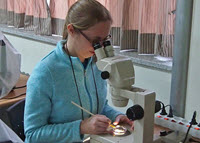
Melissa identifies a copepod at the Copepod workshop in South Korea. (Provided by Melissa Rohal)
Meiofauna provide important ecosystem services such as waste removal to the deep sea-floor environment and can act as indicators of ecosystem health. Because meiofauna live a largely sedentary life due to their small size and sediment habitat, they are often unable to escape an area affected by unusual disturbances, such as the Deepwater Horizon incident.
Melissa Rohal is investigating how oiling affects deep-sea meiofauna and how quickly their populations can recover. Her research combines community structure and function studies with modeling and socioeconomics studies to answer the question, “Do meiofauna matter?”
“There is still so much to discover and understand about the deep sea, and many of the meiofauna specimens we find in our samples are new species,” said Melissa. “Understanding the importance of these microscopic animals is becoming critical as more focus shifts to natural resources in the deep sea.”
Melissa is a Coastal and Marine System Science Ph.D. student with the Harte Research Institute for Gulf of Mexico Studies at Texas A&M University-Corpus Christi and a GoMRI Scholar with the Center for the Integrated Modeling and Analysis of Gulf Ecosystems II (C-IMAGE II).
Her Path
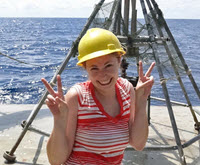
Melissa stands next to the multi-corer used to collect sediment samples. (Photo by Ben Prueitt)
Melissa became interested in the ocean as a child during visits to her grandparents’ home on Jekyll Island, Georgia. When she realized that little is known about our oceans, she was inspired to become an oceanographer; however, she was unsure of which area of oceanography to pursue. She took a broad range of courses at Coastal Carolina University’s marine science program that introduced her to the physical, geological, biological, and chemical aspects of oceanography. She also began an internship at Ripley’s Aquarium in Myrtle Beach, South Carolina, and assisted her professors with their research. These experiences helped her discover that, rather than wanting to work with dolphins or fish, she wanted to help solve the mysteries of the ocean depths.
Following her undergraduate career, Melissa worked in the Shores and Aquarium department of the Columbus Zoo and Aquarium in Powell, Ohio, and later as a marine mammal observer aboard a seismic vessel in the Gulf of Mexico. She loved being out at sea, so she applied to graduate school and accepted a position working with Dr. David Thistle at Florida State University. Her master’s work with Thistle introduced her to microscopic animals called meiofauna, which she calls her “little aliens.”
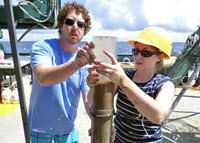
Melissa and Travis Washburn slice a sediment core for analysis. (Photo by Ben Prueitt)
While at a Benthic Ecology Meeting, Melissa attended Dr. Paul Montagna’s lecture about the effects of Deepwater Horizon on benthic meiofauna and discovered that he had an open graduate student position. Hoping to remain in the benthic ecology field, Melissa contacted Montagna and began a doctoral program working in his laboratory at Texas A&M University – Corpus Christi. Montagna later received a GoMRI-funded grant to study the effects of the oil spill, making it possible for Melissa to focus her research on seafloor-dwelling meiofauna.
Her Work
Melissa used a three-fold approach to study the effects of oil on deep-sea meiofauna and their environment. First, she input observational data and data collected from experimental toxicity studies into a fisheries modeling software called Ecopath, which helped her understand food web connectivity in the deep-sea and identify depletions in meiofauna. Next, she collaborated with fellow C-IMAGE Ph.D. student Justine van Eenennaam in the Netherlands who ran laboratory experiments looking at the response of the benthic community to Deepwater Horizon. Justine added marine snow and Macondo source oil into an aquarium containing benthic animals and then counted the animals present, including meiofauna, 80 days later to determine how the animals were affected. She sent the results and samples from the experiment to Melissa for further study.
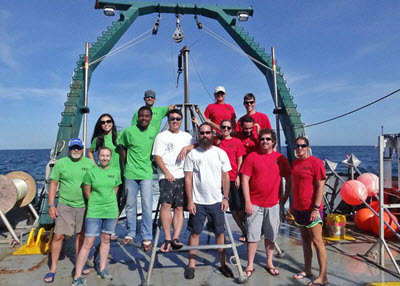
Crew of the 2016 C-IMAGE Mud & Blood cruise. ( Provided by C-IMAGE)
Melissa’s current and final step examines the meiofauna’s post-spill recovery. She and her colleagues determine recovery using sediment samples collected from the 1979 Ixtoc-I oil spill site. They use a microscope to sort and count the number of meiofauna in the samples and compare the results from cores containing Ixtoc-I oil to those without. “In the lab, we essentially play a game of hide and seek as we try to find the animals in the sediment, but I’ll admit we do cheat a little bit and dye these animals pink so we can find them more easily,” joked Melissa.
Melissa’s observations about pollution in sediment around the Ixtoc-I oil spill site will serve as a significant analog for researchers estimating the long-term effects of the Deepwater Horizon incident. Her findings about deep-sea meiofauna’s loss and recovery will inform ecosystem-modeling studies and assist decision makers and response managers who handle future oil spills.
Her Learning
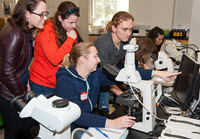
Melissa and the participants of the 2017 Benthic Invertebrate Taxonomy, Metagenomics, and Bioinformatics (BITMaB)workshop, sponsored by GOMRI, view copepod taxonomy. (Provided by Melissa Rohal)
Melissa cherishes the opportunities that her research has given her to work and communicate with scientists from many disciplines and backgrounds. She attended the annual International Meiofauna Conference in South Korea and Crete, where she connected with researchers with whom she still communicates and collaborates today. “It was an eye-opening experience to meet and talk with experts and students from around the world who share the same interests. It has led to a number of international collaborations, particularly with regards to the taxonomic identification of meiofauna, for which few experts remain within the United States,” said Melissa.
Melissa participated in the NSF-sponsored East Asian and Pacific Summer Institutes for Graduate Students, an eight-week summer program that provides science and engineering graduate students from the United States the opportunity to experience research environments, science and policy infrastructure, and languages of Pacific and East Asian nations. She spent two months in South Korea with Dr. Wonchoel Lee at Hanyang University learning to identify harpacticoid copepods. “There are few harpacticoid copepod taxonomists remaining in the United States,” said Melissa. “This opportunity improved my understanding of this second-largest group of meiofauna.”
Her Future
Melissa is exploring post-doc positions and private sector opportunities and wants to use her education and experience to help the world better understand the deep sea. She says that students considering a scientific career should never be afraid to ask questions about potential research opportunities.
“If you never ask, then you will never know,” she explained. “I fulfilled my dream of going down in a submersible simply by telling a Florida State University professor that it was my dream and to please let me know if the opportunity arose. I also fostered an international collaboration by asking if anyone at the International Meiofauna Conference was interested in conducting taxonomic studies on my master’s samples with me.”
Praise for Melissa
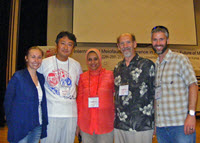
A reunion of the Montagna meiofauna lab. (L-R) Melissa, Wonchoel Lee, Hanan Mitwally, Paul Montagna, and Jeff Baguley take a group photo after Melissa won a student presentation award at the International Meiofauna Conference 2014. Woncheol was a postdoc, and Jeff and Hanan were Ph.D. students with Paul Montagna. (Provided by Melissa Rohal)
Montagna said that Melissa was a bright, motivated, and engaging student when he met her at the Benthic Ecology Meeting and was happy when she reached out to him about completing her doctorate. Her experience with deep-sea meiofauna intrigued him because his research career had begun with meiofauna but switched to macrofauna for the last 20 years. “The idea of completing the circle by working with her was very satisfying to me. Her dissertation will blend the old with the new, because our approaches today are very different than they were 20 years ago.”
Montagna says that Melissa’s work is uncovering the importance of meiofauna to the natural world. “We are getting close to the end of her studies, and it’s becoming clear that the world would not work as well tomorrow if all the meiofauna disappear today,” he explained. “Answering this fundamental question [Do meiofauna matter?] that has stumped many over the last 50 years is a truly remarkable achievement.”
The GoMRI community embraces bright and dedicated students like Melissa Rohal and their important contributions. The GoMRI Scholars Program recognizes graduate students whose work focuses on GoMRI-funded projects and builds community for the next generation of ocean science professionals. Visit the C-IMAGE website to learn more about their work.
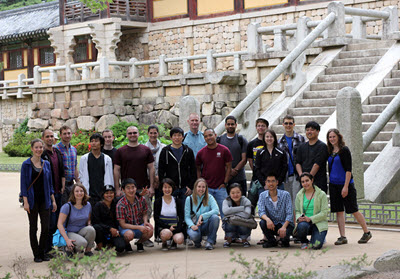
The East Asia and Pacific Summer Institutes student group. (Provided by Melissa Rohal)
************
The Gulf of Mexico Research Initiative (GoMRI) is a 10-year independent research program established to study the effect, and the potential associated impact, of hydrocarbon releases on the environment and public health, as well as to develop improved spill mitigation, oil detection, characterization and remediation technologies. An independent and academic 20-member Research Board makes the funding and research direction decisions to ensure the intellectual quality, effectiveness and academic independence of the GoMRI research. All research data, findings and publications will be made publicly available. The program was established through a $500 million financial commitment from BP. For more information, visit http://gulfresearchinitiative.org/.
© Copyright 2010- 2017 Gulf of Mexico Research Initiative (GoMRI) – All Rights Reserved. Redistribution is encouraged with acknowledgement to the Gulf of Mexico Research Initiative (GoMRI). Please credit images and/or videos as done in each article. Questions? Contact web-content editor Nilde “Maggie” Dannreuther, Northern Gulf Institute, Mississippi State University (maggied@ngi.msstate.edu).
